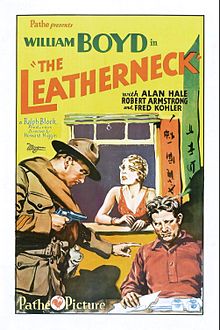The Leatherneck
| The Leatherneck | |
|---|---|
 Original film poster | |
| Directed by | Howard Higgin |
| Written by | Elliott J. Clawson John W. Krafft |
| Starring | William Boyd |
| Cinematography | John J. Mescall |
| Distributed by | Pathé Exchange |
Release date |
|
Running time | 65 minutes |
| Country | United States |
| Languages | Sound (Part-Talkie) English Intertitles |
The Leatherneck is a 1929 American sound part-talkie drama film directed by Howard Higgin. In addition to sequences with audible dialogue or talking sequences, the film features a synchronized musical score and sound effects along with English intertitles. At the 2nd Academy Awards in 1930, Elliott J. Clawson was nominated for an Academy Award in the category Best Writing (Adapted Screenplay).[1][2] Prints of the film exist in the archives of the Library of Congress and at George Eastman House.[3][4]
Plot
In the 1920s three U.S. Marines who have deserted return to their base in Tientsin, China; one is dead, one is insane and one is court martialed. On the witness stand he relates their story from the end of World War I. Following the Armistice with Germany Pvt Calhoun temporarily frees a German prisoner of war named Schmidt to go drinking with him. In the bar another Marine, Pvt Hanlon, refuses to drink with a German; their brawl escalates into a fight with the military police where the three become friends. The German eventually migrates to the United States where he enlists in the Marines.
The three Marines reunite in Vladivostok during the Siberian Intervention. The three meet a family of White Russians who have been impoverished by the Russian Revolution and whose only source of wealth is a potash mine the family owns in Manchuria. The three Marines also meet an American mercenary named Captain Heckla who attempts to recruit the Marines in a scheme to trick the Russian father out of his mine and share the wealth. The Marines beat Heckla up, with Tex marrying the White Russian's daughter Tanya.
Heckla gets his revenge by leading a group of revolutionaries who execute several citizens of the town including the father and his son, with Heckla tricking Tanya into coming with him. When Schmidt and Hanlon discover Heckla has taken over the mine they desert to investigate before telling Calhoun. Calhoun also deserts to go after Heckla and rescue Tanya.
When he arrives, he finds Heckla already dead and Buddy having been mortally wounded after a mutual shoot-out. Tex finds Fuzzy in the next room, having been driven insane by continuous torture where water was dripped on him every few seconds. Tanya can't be found and Heckla refused to reveal what happened to her before he dies. The three make their way through the desert together, but Buddy dies in Tex's arms as they travel along the river back to their base.
The military court is prepared to find Tex guilty for desertion and the murder of Buddy without any other evidence. Fuzzy, still insane, sees Tanya searching the streets. It restores his sanity and he calls out to her. Now with a witness, she corroborates the tale told by revealing Heckla took her deep into the desert. She escaped while he was drunk and spent many weeks ill in a village before coming to the city to find her husband. With the evidence presented, they find Tex not guilty of murder, and guilty of desertion with the punishment of being confined for one hour. Tanya tells her husband it was Fuzzy who called out to her and the three embrace as the picture ends.
Cast
- William Boyd as Pvt William "Tex" Calhoun
- Alan Hale as Pvt Otto "Fuzzy" Schmidt
- Robert Armstrong as Pvt Joseph "Buddy" Hanlon
- Fred Kohler as Captain Heckla
- Diane Ellis as Tanya
- Jimmy Aldine as Tanya's brother (as James Aldine)
- Paul Weigel as Petrovitch
- Jules Cowles as Cook
- Wade Boteler as Gunnery Sergeant
- Jack Richardson as Captain Brand
- Joseph W. Girard as the Colonel
Music
The film featured a theme song entitled "Only For You" which was composed by Josiah Zuro, Francis Gromon and Charles Weinberg.
See also
References
- ^ "The 2nd Academy Awards (1930) Nominees and Winners". oscars.org. Retrieved March 24, 2012.
- ^ The AFI Catalog of Feature Films:The Leatherneck
- ^ "The Leatherneck". American Silent Feature Film Survival Database. Retrieved January 10, 2014.
- ^ Catalog of Holdings The American Film Institute Collection and The United Artists Collection at The Library of Congress, p.101 c.1978 by The American Film Institute Retrieved February 4, 2015
